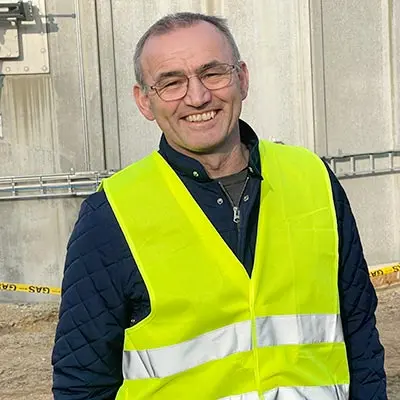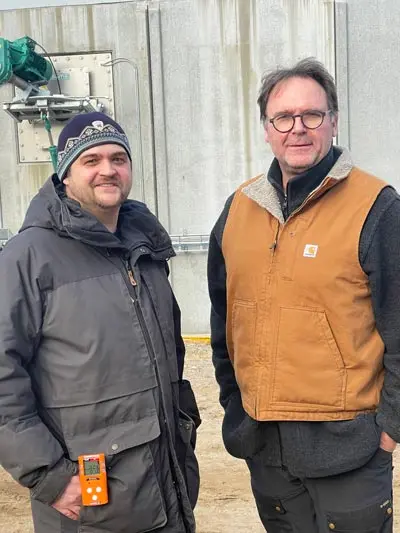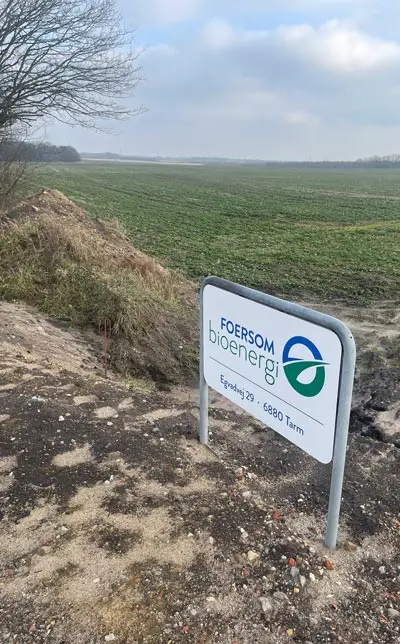Now, it is not a speed competition to build and establish a biogas plant...
But the people behind Foersom Bioenergi in Tarm have really given everything to establish biogas production in West Jutland, as quickly as possible.
The cooperation between the local farmers and Fremsyn, who designed and built the biogas plant, has been exceptionally positive, with both parties expressing their satisfaction.
The reason why it has been possible to build the biogas plant in approximately 8 months (a goal initially set at a very ambitious 100 days) is precisely that the local support has been significant and that Fremsyn has put in all the effort from start to finish to reach the goal .
An archaeological survey was carried out, but there was no need for a full excavation. However, the found earlier settlements were recorded and the artefacts found are now in the care of West Jutland museums, so this could only cause minor delay.
The construction process started in April and gas could be delivered to the network in December.

"Our desire for a local
biogas plant has been a long time in the making, which is why it is a
great joy for us farmers that it has now come to fruition", says chairman of the
supplier association Harald Olesen.
"From the start, we have been focused on the fact that a biogas plant should create value for everyone and should be able to benefit the community, so we wanted to be involved. In other words, it must also be good business for agriculture, not just for the biogas plant, otherwise it doesn't make sense for us farmers", says the chairman.
Harald Olesen, chairman of the supplier association
There are many active and
productive farms in the area, which is why there already are enough raw
materials for the current biogas production, but also for future
expansions.
The local stakeholders and raw material suppliers of livestock manure are located within a radius of only 8 kilometers from the biogas plant, which is a huge advantage when you want to lay pipes so that livestock manure can be transported to the plant and degassed biomass back to the suppliers.
The piping to the surrounding farmers reduces the transport time, the inconvenience transport on the roads can cause, and the general costs of transporting the livestock manure and the subsequently degassed biomass / residual fiber mass.
Pipelines have been established in the south and west to respectively two large swine producers and a heifer hotel, but work is also underway on pipelines to the north and east.
In the same vein, a raw gas line has been dug to a nearby ecological biogas plant, which is limited by their existing CHP gas engine capacity.
With pipes, we can harness the capacity of Foersom Bioenergi's upgrading plant, which was deliberately purchased oversized due to visions of imminent expansions, much earlier. In addition, the smaller biogas plant can also expand their production, thereby servicing more farms in their area.
Project manager Dan
Madsen, construction manager Lars Nielsen from Fremsyn and operations manager
Bo Stensgård from Ølgod, have been responsible for the
day-to-day management during planning and construction.
Now that the plant has been put into operation, Bo has taken over the daily tasks together with the newly hired operations technician Dan Damgaard.
It has been an intense construction process, where Fremsyn's own engineers and project development people have designed the facility in detail, so that they could work according to a plan for the construction. But as in all constructions, unforeseen elements always come up, which is why the plan is changed and adapted ad hoc during the construction phase.
Dan Madsen expresses his thoughts on the construction process:
"Constructing this biogas plant has given us incredible hands-on experience that we can now leverage in our engineering activities and potential upcoming projects.
A big shout-out goes to the active farmers for their excellent collaboration and feedback throughout this process. Without their input and preferences, we wouldn't have been able to build a plant that satisfies both their needs and ours.
Our vision from the start has been to make this facility as future-proof as possible, ensuring it delivers value to everyone involved in this collaboration."

Dan Madsen, construction manager and Lars Nielsen, project manager
Long residence time
Foersom Bioenergi shares many similarities with existing biogas plants, but it stands out in a few key aspects:
The facility has been designed with towering reactor tanks, reaching a substantial volume, so that in the future it is possible to inject hydrogen for methanation in the reactors, but also so it satisfies the specific needs of optimal decay and reaches maximum gas production from biomass like straw and other materials requiring an extended residence time.
These features follow extensive dialogue and were informed by the research and experiments conducted by Henrik Bjarne Møller at Aarhus University.
"We are up to a residence time of 120 days to ensure as good a decay as possible and to obtain a high gas production. There is an opportunity to increase the biomass intake without having too short a residence time", says Dan.
However, the expectation is a residence time of 65-70 days, once the plant has been completely run in with the optimal raw materials.
Minimizing methane loss is a top priority
All tanks, including the delivery tanks connected to the gas system, are equipped with covers to achieve this goal. To enhance efficiency, the pipeline connecting to neighboring farmers not only reduces transport time but also minimizes costs.
"Maintaining a good relationship with our neighbors is important in
our daily operations. That's why we plan to invite them into the plant,
allowing them to witness firsthand how biogas is produced and addressing
any questions or concerns they may have. It's an opportunity for us to
engage with them, and gives us the opportunity to let the world know how beneficial biogas is for the whole of society, in light of the green transition", highlights operations manager Bo Stensgård.
He adds: "Agriculture plays a significant role here, as we can convert animal manure, organic waste and other residual products from industries and municipalities into reliable and sustainable green energy."
Satisfied supplier chairman
The chairman of the supplier association also highlights the supplier agreement that has been concluded.
"Handing over our livestock manure for biogas production should bring value for us as farmers. We're happy of the agreement we've established with Foersom Bioenergi, as it not only adds value for us as suppliers but also ensures benefits for both parties", notes chairman Harald Olesen.
He adds: "I believe that by getting to know each other well, keeping a good tone and being open and honest all the way throughout the process, we have succeeded quite well with the agreement we've reached."
Facts about the facility
- Fremsyn was responsible for the design and planning of Foersom Bioenergi.
- LH-Bio has been a key external adviser on the design and construction of the plant.
- It features 2 primary reactors of 8000m3 and 1 degassing reactor of 8000m3 with integrated gas storage of 4500m3.
- A very long residence time is envisaged, which is why excess
capacity in the reactor volume is envisaged, also acknowledging the
desire for future expansions.
- We've added a submerged "tank yard" to address worst-case scenarios following spills or accidents. It also lessens the visual impact of the plant on the landscape. The tanks are lowered by ~2 meters compared to the rest of the facility.
- Raw
materials for production are manure, animal manure, late lawns, stale
raw materials such as grass, seed grass, feed residues,
stale grain, industrial products, etc.

Big visions, values and synergy opportunities
The overarching vision is for Foersom Bioenergi to stand out as the best plant globally for producing CO2 reductions.
We've nicknamed it "Test Center West", as all options must be kept open. Opportunities must be explored and technologies that create value must be implemented. Furthermore, we want the facility to be one that agricultural companies want to be associated with and take pride in.
Foersom Bioenergi works very closely with the supplier association to find solutions that make sense for both parties and is already looking at separation as it is expected that the dry matter content will be relatively high in the outgoing biomass, as a lot of deep bedding, straw, etc. will be used.
As a biogas plant, you must be able to deliver manageable and usable fertilizer back to your suppliers, else the promises of sustainability and the opportunities for circular economy are not fulfilled.
Ideas such as designer fertilizers etc. are also discussed between the local farmers and the biogas plant. It is about giving agriculture the benefit of a biogas plant that can deliver a balanced nutrient composition to the crops on individual farms.
The future looks bright
The facility initially engaged with a gross list of 7 suppliers, but the overwhelming interest has led to a current waiting list of 23, so future expansions are already in the planning stages.
The expected production capacity, in the form of subsidized production, is anticipated to reach 6 million Nm3.
Pyrolysis is also obvious to look into when you still have a separation step and a fiber fraction that needs to be done. The fiber fraction should be considered a valuable phosphorus fertilizer and traded as such on the market. This is not where a biogas plant should make its earnings, but the costs should be covered by the price tag. Pyrolysis will give rise to a direct CO2 bond in the soil when returned to agriculture, and the settlement of this is not yet known. But there is also value creation here, the final design of which has not yet been seen.



How long does it take to build a biogas plant?